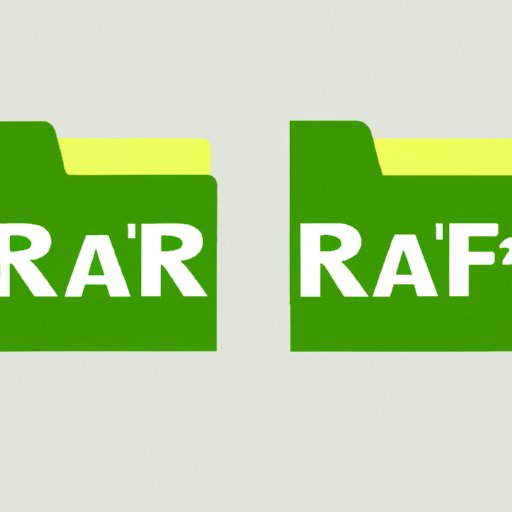
I. Introduction
If you’ve ever downloaded a file from the internet, you may have encountered a .rar file and had trouble opening it. .rar files are archive files, which means they contain one or more files that have been compressed into a single package. These files can be tricky to work with if you’re not familiar with their unique properties, so we’ve put together this comprehensive guide to help you learn how to open and manage .rar files with ease.
II. Understanding .rar Files
Before you can open a .rar file, it’s important to understand what it is and how it works. .rar files are compressed archive files that use a proprietary compression algorithm to reduce the size of the files they contain. This can make them much smaller than the original files, which is useful for sharing and storing large files.
In addition to compression, .rar files have some unique features that can make them more challenging to work with than simpler file formats like .zip files. For example, .rar files can be split into multiple smaller files, which can make them easier to transport and share over the internet. However, this can also make them more complicated to extract, as you’ll need all of the files in the set to fully extract the archive.
Other issues that may arise when working with .rar files include incomplete downloads, corrupt archives, and password-protected files. We’ll discuss how to address these issues later in the article.

III. Options for Opening .rar Files
There are several software options for opening .rar files. The most popular options are WinRAR and 7-Zip, both of which are free to download and use. These programs offer a range of features beyond basic extraction, such as the ability to test archives for corruption and repair damaged archives.
If you don’t want to download any software, there are also several web-based decompression tools that can help you extract files from .rar archives. Simply upload your file to the website, and it will be automatically decompressed for you.
Finally, some lightweight file managers, such as Total Commander or FreeCommander, can also open and manage .rar files. These programs offer additional features beyond basic extraction, such as the ability to view and edit metadata and rename files within the archive.
IV. Steps for Opening .rar Files
Opening a .rar file with software like WinRAR or 7-Zip is a simple process:
- Locate the .rar file on your computer.
- Right-click on the file and select “Extract Here” or “Extract Files”.
- Wait for the extraction process to complete.
- Once the extraction is complete, the files will be available in the same directory as the .rar file.
If the .rar file is split into multiple parts, you’ll need to select the first part and then extract it. The other parts will automatically be extracted in sequence.
Here is a visual guide to opening a .rar file using WinRAR:

Similar steps can be followed with other software options, as they all have similar user interfaces.
V. Troubleshooting Common .rar File Issues
Like any file format, .rar files can have issues that prevent them from being opened or extracted correctly. Some of the most common issues include incomplete downloads, corrupt archives, and password-protected files.
If you encounter a corrupt archive or a broken file, you may need to try redownloading the file or repairing the archive using software like WinRAR. Password-protected files can also be more challenging to work with, but most software options will prompt you to enter the password before extraction.
If you’re having trouble with a specific .rar file, it’s always a good idea to do a quick internet search to see if others have experienced similar issues and what solutions have worked for them.
VI. Common Scenarios for Using .rar Files
.rar files are commonly used in a few specific scenarios, such as downloading software installers or working with game mods. If you’re encountering a .rar file in one of these contexts, there are usually specific steps you’ll need to follow to extract it properly.
For example, if you’re working with a game mod, you’ll typically need to extract the .rar file into a specific directory within the game’s installation folder. Make sure to read any instructions or documentation that came with the mod to ensure you’re following the correct steps.
Similarly, if you’re downloading a software installer that’s packaged as a .rar file, you’ll need to extract the files before you can run the installer. It’s important to only download software from trusted sources to avoid downloading malware or other harmful files.
VII. Advanced Features of .rar Files
While the basic process of extracting files from a .rar archive is relatively straightforward, there are some more advanced features of .rar files that you may encounter. For example, .rar files can be password protected, meaning you’ll need to enter a password to extract the files. Additionally, .rar files can store metadata, such as comments or file ownership information.
If you need to work with these more advanced .rar features, consult the documentation for your software or do a quick internet search to find the appropriate steps.
VIII. Best Practices for Managing .rar Files
Finally, like any file format, it’s important to follow some best practices for managing .rar files to ensure they stay organized and easy to work with. Some tips include:
- Use descriptive filenames that accurately reflect the contents of the archive.
- Group related archives together in a single directory or folder.
- Delete or archive old files that you no longer need to save storage space.
IX. Conclusion
We hope this comprehensive guide has helped you feel more confident in your ability to work with .rar files. While they can be more complex than simpler file formats, with the right software and knowledge, you can easily open and manage .rar files with ease.





